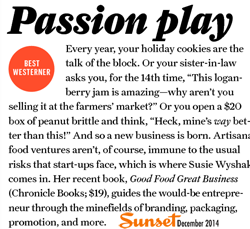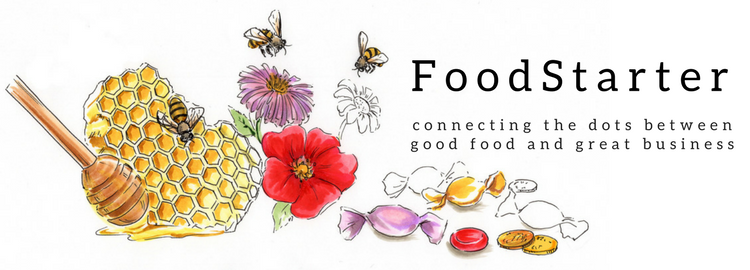This is Part 1 of a 4-Part Series: Re-imagining Good Food Business
(Written in 2020, some of the information may be out of date so check for the latest knowledge before making real-life business decisions.)
When I began writing, birds, not buzz saws, hummed outside. Wind, not cars, whizzed down the street. Then shelter-in-place subsided. The white noise of cars and the BART subway system and leaf blowers hearken the old normal. What have we learned from the clean air and coyotes roving the streets as we sheltered-in-place?
This project began as a simple update to my book Good Food, Great Business: How to Take Your Artisan Food Idea From Concept to Marketplace. Then leaders of major food companies and governments began admitting they have no idea what our New Normal will be. Writing a Kindle book, which I’m now posting here for free, became an exercise in thinking of the food future I would like to help create.
A Several Year Look Back
Good Food, Great Business came out in 2014. At the time, food trucks and craft food fairs fed streams of #foodporn selfies. “Handmade” signaled interesting. A quest for cronuts crammed people together in lines. People sought out hot food crafters and trendy restaurants. And bars!!! (They actually took bites from each others’ plates and tasted each others’ drinks.)
Fans flocked to Smorgasburg, Renegade Craft Fairs, the Brooklyn Flea, the Good Food Mercantile, and other pop ups in search of the latest good foods. The world was our oyster. All you had to do was make something tasty and interesting for people to line up (less than six feet apart) for the privilege of sitting on a street curb to chow down.
Plastic bags had been outlawed, and stores charged for the shame of requesting a paper bag or disposable coffee cup.
Boulder-based Justin’s Nut Butter was still a fairly young company when I interviewed Justin about his journey. Now the company is part of Hormel. Yes, that Hormel. Other companies profiled in Good Food, Great Business were also acquired by larger companies. Others shut down as the founders’ lives changed or the businesses simply were not viable. Many more grew, helped by lessons imparted through the book, along with guidance from mentors, incubators, and their own hard work.
Amazon didn’t yet own Whole Foods. The company Buyers’ Best Friend, which had built an efficient system for wholesale buyers to order directly from producers, was acquired and pivoted to focus on corporate kitchen snacks—a market full of potential before the pandemic. Now RangeMe has filled the void somewhat; Whole Foods and other retailers point producers to this site to set up online “brochures” in an attempt to connect with buyers.
As we all know, within a few surreal weeks in early 2020, the food world changed. Cramming into a booth at a restaurant seemed as realistic as joining the Seinfeld gang at their diner. People quickly moved to re-create restaurant and bar experiences at home: Cooking classes flooded Instagram. Quarantinis drinks paired with house-made sourdough bread became the stuff of Zoom happy hours. (A year later in March 2021, the bread craze seems like a distant memory!)
People also loaded up on small appliances. Waffle irons! Sandwich makers! Sales of bread makers leapt more than any other discretionary item.
Virtual food trade shows replaced 2020 Natural Products Expo West and the Summer Fancy Food Show. None of this mattered, at least temporarily, since grocers stopped seeking new products for the most part to focus on simply surviving—businesswise and literally, as employees became frontline, essential workers feeding panicked consumers.
Most of us in the U.S. are incredibly blessed with access to food. Yet we have all seen empty shelves and scrambled to load up. The year 2020 delivered many a bitter pill to entrepreneurs who put their lives on the line and sank their passion and savings into all sorts of food businesses, from small manufacturing plants to restaurants, food trucks and farms.
Overshadowing food distribution debacles coupled with panic-driven hoarding were stories of horrible food waste and cruelty: Hundreds of thousands of factory-farmed pigs “euthanized” and buried. Milk and eggs dumped. Meanwhile, people lined up at food banks, desperate for food.
Things need to change. Better food security means more diverse production and more robust local, humane food production with strong connections between producers, distributors, and buyers.
On to Part 2: Food Business Imperatives
Or skip it all for the bottomline:
Before doing anything, skim an article predicting that the Specialty Food Association’s more than 4,000 members face unprecedented challenges, from liquidity to distribution, that will last long after the pandemic.
Stop everything? On the contrary. It’s time to invest in new product innovations. Get a head start in engaging consumers seeking new foods when the new normal becomes normal. “History shows companies that retain their investment in innovation benefit significantly in the longer term,” according to the research company Nielsen’s.
During the pandemic, clients continued to invest in creating new foods with the OSU Food Innovation Center. Sprout’s Market, Natural Grocers, Erewhon in Los Angeles, and other natural foods markets looked to open new locations. While the media reported failures and retrenching, these companies saw the future and worked toward their visions.
Key points for food startups:
- Product: Is what you’re creating different and great enough that people will want to buy it at the price at which you need to sell it?
- Branding: A dude at Costco picked up a bottle of hand sanitizer made by a local distiller and declared “I’m buying it just because of the cool label.” Your branding needs to be elegant, or cool, or fun. It can’t be “I made this myself because I’m cheap.” or “I made this myself because I know what people want.” Everything about your brand needs to have a purpose, from the logo to the finish on your package or labels (glossy—so you can wipe it off or so it looks “elegant”—or matte, a more natural and rustic modern look). In a pandemic does branding matter? My extremely busy sister drove 2 hours to buy hand sanitizer from a distillery for her medical practice. She bought the bottle with the cool label. Good branding is everything, whether your customer is an urban male shopper or a rural female shopper. So, the answer is: Yes.
- Shipping: Do you want to ship yourself or sell to other companies who will ship it as part of a box or an online marketplace? If you’re shipping it, exactly how will you do so and how much will it cost? Consumers love free shipping. Consider your overall costs and profit margin when looking at these factors.
- Distribution. Be sure not to finalize your product before you finalize your distribution! This means diverse packaging and fall-back distribution plans for when Plan A is out of commission. Remember, at this point, it’s hard to go wrong by selling online to begin with, even if it’s for local pickup and delivery.
- Be flexible. Plan both a “normal world” and a “shelter-in-place world” strategy—which will happen to serve home-bound people when the majority of us aren’t sheltering. Worst-case scenarios might include not having access to raw materials packaging and any labor.
- Connect! Collaborate and ask for help—but thoroughly vet partners. Take part in online food networking events, bootcamps, and tradeshows as well as Facebook groups and mailing lists for entrepreneurs in your area.
Turn to my list of links for FoodStarters for resources.
On to read Part 2
Comments, questions, ideas? Get in touch with Susie.






